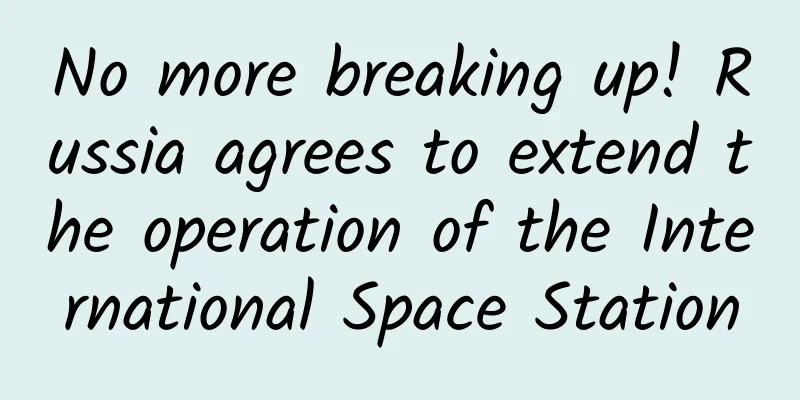No more breaking up! Russia agrees to extend the operation of the International Space Station

|
Recently, the Russian State Space Corporation announced that the Russian government has sent a letter to the leaders of the space agencies involved in the International Space Station project, informing them that the Russian government has agreed to support the International Space Station until 2028. The International Space Station is the world's largest space project and has been in orbit for more than 20 years. Russia has previously stated its intention to withdraw from the project in order to build its own space station. So why did it decide to continue cooperation? International Space Station photo (Source: NASA) High investment cost and aging equipment The International Space Station is led by the United States and Russia, with 16 countries and organizations including the European Space Agency, Japan, Canada, and Brazil participating in its construction and operation. It is the largest, longest-lasting, and most-country-involved international space cooperation project in the world's history. The International Space Station provides the world's largest space experiment platform. Participating countries have carried out numerous scientific research, technology development, space exploration, commercial and educational activities, and have continuously produced important results. More than 100 countries have participated in the application of the International Space Station, sending astronauts to the space station to conduct space experiments or other extended activities. The International Space Station was built in 1998, and its aging problem is becoming increasingly serious. In 2021, Russia evaluated the operation of its own modules and determined that most of the equipment was aging and the maintenance cost was high. Astronauts spent more and more time maintaining space station equipment and less and less time conducting scientific experiments. In recent years, the countries participating in the project have been considering the subsequent operation issues. At the end of 2021, the United States promised to support the operation of the International Space Station until 2030. Member states of the European Space Agency, Japan, Canada and other countries have also expressed their willingness to continue cooperation, but Russia once planned to withdraw. In July 2022, the Russian State Space Corporation stated that Russia will withdraw from the International Space Station after 2024 and deploy its own space station. Russia believes that the cost of maintaining the operation of the International Space Station is too high. The annual operating cost of the United States is about 4 billion US dollars, while Russia has spent more than 30% of its space funding on the International Space Station, and the investment does not match the return. The construction of the country's space station is on the agenda Russia is the main force in the construction and maintenance of the International Space Station, but there are relatively few on-orbit application research conducted in the Russian module, and experimental projects account for about 20%. The Russian module was launched first and has limited functions. The later deployed Search and Dawn modules are small in scale and are not dedicated research facilities. The on-orbit experimental environment is limited. The orbit of the International Space Station passes through Russian territory for a short time, which is not conducive to conducting earth observation. In 2016, the Russian government approved the "2016-2025 Federal Space Program", in which Russia proposed a plan for the development and application of the space station, providing about $180 million to launch the Science Multi-Function Experimental Module, the Pier Node Module and the Science Power Module. The deployment is planned to be completed by 2024, and then the country's space station will be established on the basis of the three new modules. In 2021, the plan was changed to redesign and build a new space station, and the Science Power Module will become part of the new space station. At present, the Russian module on the International Space Station consists of the Zarya functional module, the Zvezda service module, the Science experimental module, two small modules, the Searcher and the Dawn, and the Pier node module. Among them, the Zvezda service module is the core module of the International Space Station and the main place for astronauts to live and work. In July 2021, Russia launched the Science multifunctional experimental module, which has 33 general-purpose workstations for scientific experiments. Using the payload airlock and robotic arm, extravehicular experiments can be remotely controlled from inside the cabin. The high degree of automation has significantly improved the application efficiency of the space station. The Science experimental module includes multiple subsystems such as life support, propulsion, flight control, and thermal control, and provides cargo storage space, which has greatly improved Russia's space test capabilities and improved the working and living conditions of astronauts. In terms of independent space station construction, Russian aerospace experts said that the preliminary design of the new space station will be completed this year, and the deployment schedule will depend on the results of the conceptual design. The initial plan is to launch the research and energy module first at the end of 2027, and the connection module, transition module, basic module and special module from 2028 to 2030. Schematic diagram of Russia's new space station (Source: Russian State Space Corporation) Russia has high hopes for the new space station and is determined to reshape its manned space engineering system. Russia's current manned space missions are all carried out at the Baikonur Cosmodrome in Kazakhstan. Now Russia is building a new manned space base on its own, including a new transportation system, ground infrastructure, and comprehensive facilities for astronauts at the Vostochny Cosmodrome. Although Russia has previously announced that it will withdraw from the cooperation with the International Space Station, its own space station is not expected to be put into use until 2028 at the earliest. If it withdraws, it may face a window period of at least 4 years. In early February this year, the Russian State Space Corporation held a meeting to discuss the technical status of the Russian segment, measures to extend its life, medical support and plans to expand scientific application research. It decided to apply to extend the service life of the Russian segment of the International Space Station to 2028. This plan was approved on "World Space Day" in April this year, and a letter was sent to the space agencies of participating countries to inform them. Russia extended its cooperation on the International Space Station, on the one hand, to ensure the continuity of its manned space program and maintain its domestic design and production capabilities; on the other hand, it was also to safeguard its national reputation and technological sovereignty. Future development faces uncertainty After Russia expressed its agreement to extend the life of the International Space Station, the United States immediately stated that it would "continue to work with partner countries to ensure the uninterrupted presence of countries in low-Earth orbit and a safe and orderly transition from space stations to commercial platforms in the future." There will still be great uncertainty about the direction of the International Space Station after 2028. On the one hand, the United States will continue to allocate funds for the International Space Station until at least 2030, while promoting the "Commercial Low Orbit Development" plan to support Axiom, Blue Origin, Lockheed Martin and other companies in the development of commercial space stations. NASA hopes that the commercial space station can enter operation in 2026, and NASA will directly purchase functions and services as a customer to achieve full commercial support for astronauts' round-trip and stationing, space experiments and payloads. In response to the possibility of Russia's withdrawal, the United States is also making up for its shortcomings in independently supporting the operation of the International Space Station. From implementing the commercial space manned program to the first orbital lift test using the Cygnus cargo spacecraft in 2022, it reflects the United States' determination to enhance its ability to independently support the operation of the space station. For Russia, the duration of its participation in the International Space Station project will depend on the technical status of the Russian module and the timetable for deploying its own space station. Although Russia has advanced space station construction technology and rich maintenance experience, its investment in aerospace is far behind that of the United States. In addition, the country's economic situation is not optimistic due to factors such as the Russia-Ukraine conflict, and its aerospace development plan is often subject to changes due to funding and other reasons. Whether Russia can launch its own space station on time remains a question mark. In addition, the manned space industry needs the support of a complete and powerful aerospace industry system. For example, launching space station modules requires a high-thrust rocket, and the International Space Station relies on the space shuttle and the Proton rocket to launch the main components. At present, Russia's Proton rocket is facing retirement, and the remaining few stocks will be consumed in the next few years. It remains to be seen whether the new Angara A5 rocket can take on the task of building the country's space station. (Author: Yang Shirui) |
Recommend
How to improve conversion rate? Here are 9 suggestions for you!
A design change can increase website click-throug...
Pinduoduo Product Analysis Report
Pinduoduo has developed rapidly since it appeared...
Why has Proxima Centauri become the “C position” in science fiction works?
Editor's note: Recently, the domestic science...
Teresa Teng's information: Is website access rate an important indicator for SEO? How to improve the access rate?
A good website requires not only perfect web desi...
Reasonable planning: How to choose the right database for your app?
This article is reproduced from the public accoun...
How to turn on activity conversion? Share 3 types of gameplay with built-in traffic!
Regardless of the type of activity, the ultimate ...
In her two years at Tencent, she learned these 15 content management tips
Two years ago, I graduated with a master's de...
Exclusive interview with Yan Zhitao, Vice President of R&D at TalkingData: Uncovering the secrets of big data
[[123691]] In the era of big data, the value of d...
Case analysis: How to build a user incentive system?
The construction of a user incentive system is ge...
Your Android app doesn’t need that many permissions
Android system permissions can be a bit confusing...
Pinduoduo’s paid membership model and operational ideas!
Everyone is familiar with the gameplay of paid me...
Is it prostate cancer as soon as it is discovered? Men have these minor symptoms, indicating that there may be something wrong with the prostate
Going to the toilet more often and urinating more...
Information flow advertising is so popular, how should we play it? (In-depth information)
This article takes you to explore the following i...
AMD's new top-level graphics card debuts: Can it really beat GTX 1080?
Yesterday, AMD highlighted the new generation of ...
W3C releases Mobile Checker
Mobile Checker (official website) is a mobile pag...









